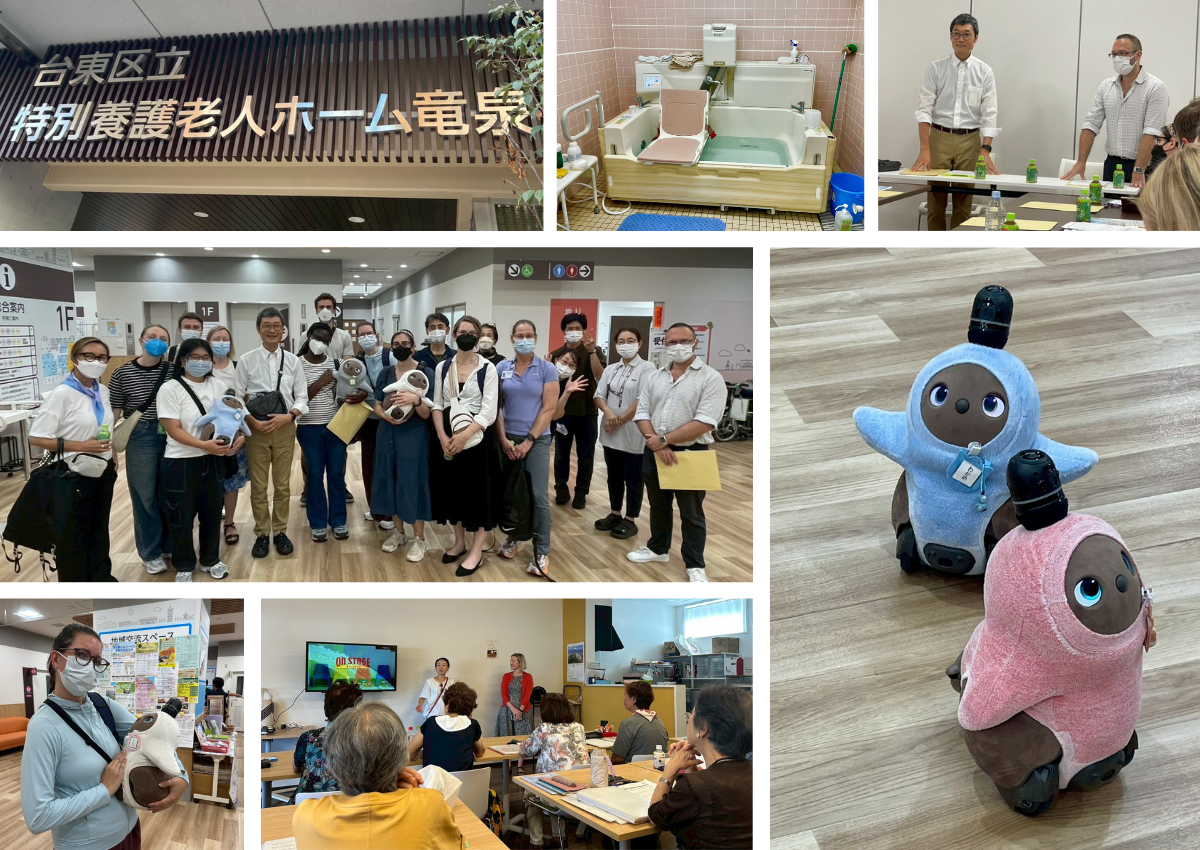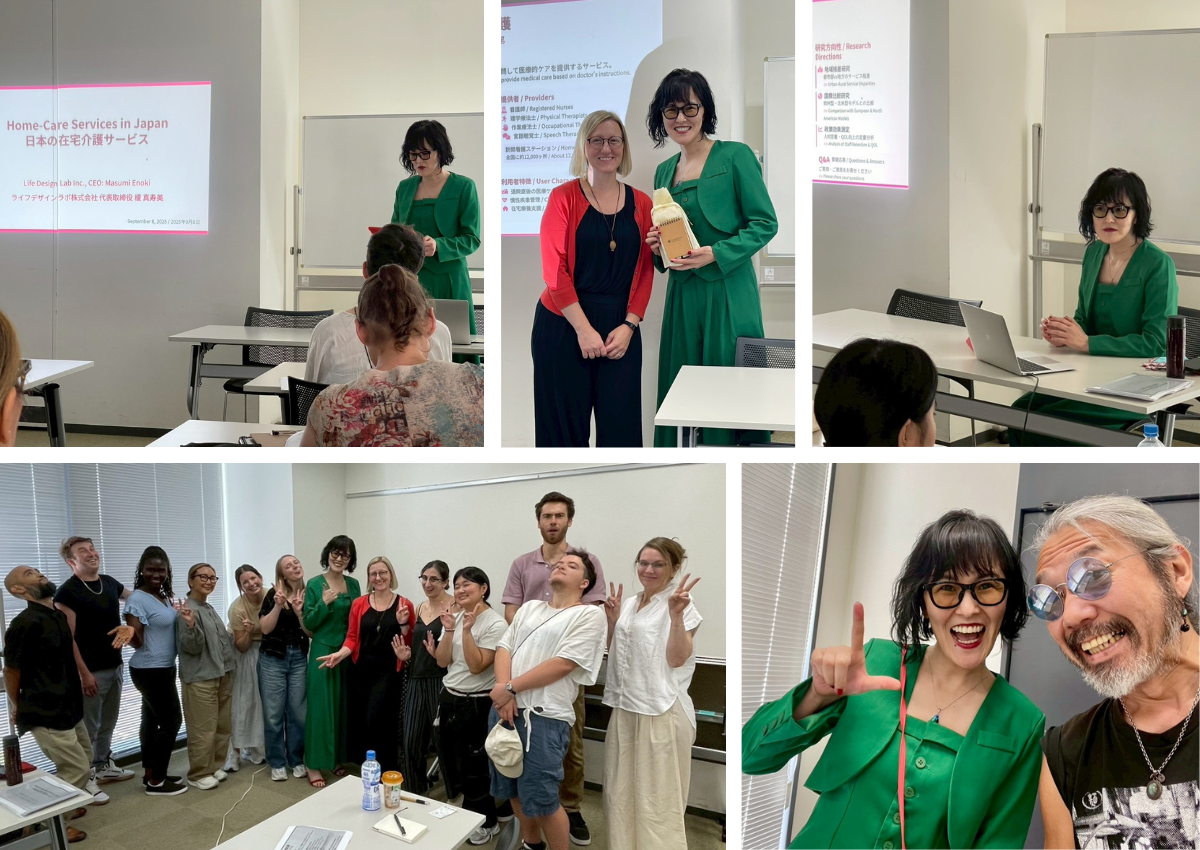Short-Term Program Spotlight: Exploring Japan’s “Super-Aging Society” with Portland State University
If there’s an ideal place to study the challenges and opportunities of an aging population, it’s Japan. Compared to 16% in the U.S., 28% of Japan’s residents are 65 years or older, making it the perfect living laboratory for Portland State University’s September short-term program on the theme of “Super-Aging Society,” led by faculty member Jacklyn Kohon and EdOdyssey Program Leader Yuki Kudo.
LEARNING OBJECTIVES
With about a week in Japan, students explored:
The dynamics of an aging population
Japan’s long-term care insurance system
Informal and community-based supports for older adults
The impacts of aging in urban vs. rural contexts
Hands-on community engagement through a service-learning activity
Looking at both urban (Tokyo) and rural (Akita) contexts, the group combined classroom learning with guest speakers and excursions that allowed them to engage with the community, including local professionals. Students delved into the structural and informal supports that older people rely on in Japan, and they talked to gerontologists, social workers, and community developers who deal with the daily realities of an aging population.
Between savoring unforgettable Japanese flavors, following their cultural curiosity during free time, and bonding with classmates, students will look back fondly on many unforgettable highlights. Below are a few!
A DAY IN KASHIWA: A GUEST LECTURER & HOUSING COMPLEX TOUR. The first full day began in Kashiwa with guest lecturer Dr. Jun Goto, an Associate Professor in the Department of Architecture and Building at Tokai University, specializing in urban planning and community design. He is part of a large project dedicated to designing spaces for communities of elderly people to live independently while remaining engaged with their community. Students also heard from guest lecturer and tour leader Dr. Mai Takase of the University of Tokyo. After a shared lunch to continue the conversation in a more informal setting, students toured the Toyoshiki Housing Complex. This neighborhood has been the focus of several collaborative projects between Kashiwa City, the Urban Renaissance Agency, and the University of Tokyo with a goal to create more age-friendly urban design, including accessible outdoor spaces, walkways, and benches to support social interaction and accessibility.
VISITING RYUSEN SPECIAL NURSING HOME FOR THE ELDERLY. Students visited this community-based care facility which emphasizes dignity, small group living, individual needs, good communication between residents and staff, and maintenance of meaningful relationships with family and friends. Values focus on respect, family roles, and intergenerational connection, all themes that are especially meaningful in Japan. Plus, students loved the cute robots that act as companions for elderly residents.
ENGAGING WITH CREATIVE AGING ZUTTOBI. Japan’s first public art museum, the Tokyo Metropolitan Art Museum in Ueno, is not just for exhibitions, but also a hub for cultural exchanges and creative dialogues. Here, students learned about Creative Aging Zuttobi. “Creative Aging” is a concept that emphasizes creativity in aging, to see aging not as decline but as a stage of life that is rich with possibility. Since 2021, the program has launched a range of initiatives to keep the museum (and art, generally) welcoming, relevant, and accessible—physically, socially, cognitively, and emotionally—for older adults, including those with dementia.
EXPLORING TOKYO METROPOLITAN INSTITUTE FOR GERIATRICS AND GERONTOLOGY. Interacting with local professionals, students learned about the work and research that takes place at the Tokyo Metropolitan Institute for Geriatrics and Gerontology. Aging is studied from a variety of different angles here: biological, clinical, and social. Researchers look at aging mechanics, research disease prevention, diagnostics, health promotion, and how to improve the quality of life in later years. They even have a “Healthy Aging Innovation Center” where lab findings are applied in real-world contexts like the development of wearables, blood tests for early detection, and AI that can analyze large sets of data to spot patterns in aging.
DINNER WITH AN AKITA POLITICIAN. When students arrived in Akita, they shared a welcome dinner with Nobufumi Takeuchi, a member of the Akita Prefecture Council. He has been involved in several large government-funded projects for social welfare and shared with students the government’s work to support a large aging population. They were also in for a treat from the restaurant, which featured a classic Namahage performance—an iconic cultural tradition in Akita, which student Max Goldman noted was “incredible.”
LEARNING, RELAXING, AND EATING AT A SOTO ZEN BUDDHIST TEMPLE. “Standing in the garden at the Dairyuji Temple [was not only] where I felt the most connected to nature, but where I felt the most safe to foster connections,” student Benji Hayes wrote in the post-program evaluation. At Dairyuji, a soto zen buddhist temple, students focused on community engagement, listened to guest speaker and Akita local Ryu Yanagisawa, and fit in some project work. In fact, the visit to Dairyuji was mentioned several times in post-program evaluations, including by student Kelsey Lovik, who noted it as one of the most powerful or memorable moments of the program, sharing, “Community cooking at the Dairyuji Temple was so special. We learned about local foods, and I realized that you don’t need very much language to share a memorable experience with someone.”
A VISIT TO A LOCAL COMMUNITY CENTER. Students visited a local community center and talked with Mrs. Mio Kimura and Mrs. Yoriko Saito and to active older women who talked with about community activities, support, and chonaikai (neighborhood associations).
AN AKITA CITY URBAN PLANNING ASSOCIATION TOUR. Students took an Akita City Urban Planning Association Tour with Kazu Saito, who works for the city office. His focus is on sharing revitalization projects that the city has undertaken and how the urban design of these projects keeps elderly community members in mind. As an area with a large community of elderly people, Akita has been a member of the WHO Global Network for Age-Friendly Cities and Communities since 2011, and the city has committed to designing accessible environments and services focusing on keeping older people active, healthy, and well-integrated in community life.
A TRADITIONAL RYOKAN EXPERIENCE. No trip to Japan is complete without a stay in a ryokan. Students were able to experience this Japanese tradition at Akakura Sanso in Gojome Town. This facility was originally established to promote forestry production, and the hot springs date back to the 1600s! This was a wonderful cultural immersion into Japanese aesthetics, the appreciation for slow living, and the art of omotenashi (hospitality).
PARTICIPATING IN A SERVICE LEARNING ACTIVITY. Another impactful activity that students participated in while they were in Akita was a service learning project in the historic Gojome Market, said to date back to about 1495. Dairyuji Temple’s guest speaker Ryu Yanagisawa worked with the local Gojome community (an area with a high population of elderly residents) to bring the farmer’s market back to life and, alongside lending a hand at the market, students learned about his work over a meal at a diner run by his family. Kelsey reflected in her post-program evaluation, “Helping with the morning market in Gojome helped me to see the resilience and beauty of a neighborhood.”
LISTENING TO A GUEST SPEAKER ON IN-HOME CARE SERVICES. As the program came to a close, students met one last guest speaker: Masumi Enoki who talked about in-home care services for older adults. She owns and operates a business that has trained medical and support staff go into the homes of individuals living with disabilities on a regular basis to help them. This includes basic medical check-ups, making them meals, doing their laundry, changing bedding, taking out trash, and more. Her business supports people of all ages who live with disabilities, but her presentation focused specifically on helping older people with disabilities. Many older people in Akita are still very active, healthy, and strong. However, many do still need help and experience disabilities over time, while not quite ready for an assisted living environment.
TRAVEL CHANGES PEOPLE; PEOPLE CHANGE THE WORLD
"We learned about Japan's Super-Aging Society from a multitude of perspectives, met wonderful people, learned about ourselves, and made lasting friendships along the way,” Portland State University Faculty Leader Jacklyn Kohon said. “Students have demonstrated great adaptability, kindness, perseverance, and good humor, which made the whole experience so beautiful and easy….I had the great privilege of introducing students to the magic, joy, and beauty of Japan.”
“What I learned,” student Max Goldman shared on his post-program evaluation, “is that, in order for our society in America to become even better, we should adopt or be open to the ways that other countries run their cities and take care of their populations.”
Read Portland State University’s own recap of their program with EdOdyssey here.
Keeping an open mind and learning from the different ways of living and perspectives we encounter on our travels plays a core role in our belief at EdOdyssey that travel changes people; people change the world.
Have an idea for a short-term program you’d love to explore with your own students? Let’s start a conversation.”














